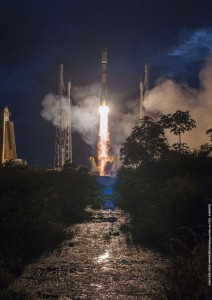Arianespace has orbited the two latest satellites in the Galileo constellation, the seventh and eighth named “Adam” and “Anastasia”. The Soyuz VS11 launch from the Guiana Space Center took place on Friday, March 27 at 21:46 GMT. The medium-lift Soyuz performed a flight of nearly 3 hours and 48 minutes to deploy both spacecrafts.
After an initial powered phase of Soyuz’ three lower stages, the launch included two burns of the Fregat upper stage, separated by a three-hour-plus ballistic phase, to place the two 700-kg.-class satellites at their targeted deployment point. Total payload lift performance for the flight was estimated at 1,597 kg. on a mission to a circular medium-Earth orbit.
During post-launch comments from the Spaceport, Arianespace Chairman and CEO Stéphane Israël thanked and congratulated everyone involved with the Soyuz mission. He said there are six more Galileo launches to come: three missions on Soyuz with six additional FOC satellites, and three launches on Ariane 5, with 12 more units.
“The satellites are doing fine and are in good hands, managed by the Toulouse CNES operational center,” added Didier Faivre, Director of Navigation Programs for ESA. “Let’s rejoice with this very good news. We will be back as soon as possible to continue deploying our satellites.”
Arianespace successfully resumes Galileo launches after Flight VS09, where the fifth and sixth Galileo satellites were injected into an orbit lower than intended. Arianespace appointed an independent inquiry board and set up an action plan based on the board’s recommendations, which enabled Soyuz to resume launches from the Guiana Space Center beginning in December 2014, with the VS10 mission.
The success of last Friday’s VS11 mission follows in the footsteps of the action plan. The next Soyuz launch for Galileo is now set for September 2015, on VS12.


